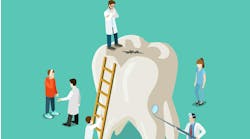Part II
Editor`s Note: The first segment of this point/counterpoint series appeared in the April 2000 issue.
The benefits and advantages of digital radiography made the author go from detractor to supporter of this new technology.
Mike Maroon, DDS, FAGD
I was asked to read the article in the last issue of Dental Economics by Drs. Thomas Schiff and Jack Hadley of the University of the Pacific School of Dentistry on the benefits of traditional film as it pertains to digital radiography and make some comments. I found their article to be very informative ... containing several points that I agree with and also several misconceptions that many people have about the two different types of technologies. Personally, I believe the digital vs. traditional debate in dentistry closely mirrors the same debate that is currently occurring in the field of photography. Perhaps the best way to comment will be to itemize each point and give my views.
Drs. Schiff & Hadley state "...opinions about film and digital imaging technologies for dentistry are amazingly susceptible to distortion." They continue, "Compounding this problem is that those who lead the debate are often more heavily invested than the average dentist, and it is human nature to overstate one`s position when the stakes are high." I can understand how they may view it this way. There is a financial component to every position. The same statement can be made for traditional film as well. Are we to believe that the manufacturers of traditional film or those promoting it will not benefit financially from convincing people to the merits of their technology? I think it better to discuss the benefits and advantages of each technology and allow each individual to decide on their own whether they are ready to make that leap of faith to embrace the new technology.
They go on to say that "a fact" can be presented in multiple ways, depending on how it is framed. Consider the "time it takes to process film" question. If you interpret this question as pertaining directly to automatic processor throughput, you get one answer. If you interpret the issue in terms of how long it takes a dental assistant to load a film study on the way to the next operatory where a patient waits to be prepped, plus how long it takes to grab the processed film on the way back from answering the phone at the front desk, you get a very different answer.
Either way, using their argument, the time that it takes to process traditional film will take longer than with digital technology. In fact, that is one of the major benefits of digital technology ... immediate results. There is no waiting whatsoever! No waiting for the team member to process the film and no waiting for them to load a film study. The digital images are instantaneously present on a computer screen and with appropriate networking can be viewed throughout the entire office immediately. This significant timesaving can mean thousands of dollars in increased revenue to a highly efficient dental practice over the course of a year. On top of that there are savings on purchasing and disposing of chemicals, as well as the need for a darkroom.
Drs. Schiff and Hadley make a point that I agree with, "...there is the equally unrealistic notion that the film vs. digital debate has a single answer ... Dental diagnostic imaging is not a subject that lends itself to a one-size-fits-all solution. And that is not a bad thing. The more choices we have in imaging technology, the more we can refine our menu of imaging services."
As time goes on, digital imaging will only get better. We will have improved sensors. We will have the ability to have all types of images available digitally (including panoramic and cephalometric).
The only question becomes: When do you get involved with this technology? Should you wait until the technology is perfected, or do you get involved and enjoy all the benefits today? Think about it. Do you have a color television, a VCR, or a cellular phone? When and why did you purchase them? What benefits did you achieve by getting involved when you did?
As you can imagine, there will be several different answers depending on your own unique beliefs and values. Digital radiography has already gone through its preliminary growing pain stages and is an extremely reliable and worthwhile product today.
Tried and True...
I am in total agreement that film technology has been around for years and that it has an excellent track record. However, is that really a reason to retain a technology, even if it may be outdated? Given this premise, why aren`t there still Model-T Fords being sold? How about typewriters or telegraph systems? The reason is that, even though the technology was around for years and had an excellent track record, a new technology came along that took all the benefits of the old technology and improved upon them. This is exactly what digital radiography does with film.
The argument about different companies and different software programs is correct. There will always be a positioning of companies in the marketplace. That is the basic tenet of capitalism, which makes America a great country. You should look at the company that you will be doing business with and see if they will have staying power. However, even the strongest of companies will undergo change at one time or another.
More attention should be paid to the format that the images are captured in. Most of the images are in .jpeg or .gif format, which means they are readable and compatible with just about any software program on the market today. It behooves any manufacturer who is considering a software upgrade to make sure that these file formats are transferable from one software program to another. I am not worried about the compatibility issue at all.
Regarding training, it really doesn`t matter whether the digital radiography is taught in dental schools, assisting schools, or hygiene schools. All that is needed is a basic understanding of X-ray beam positioning and the type of radiographic image you are looking to capture. Most of the software programs are simple to use and can be mastered by anyone in just a few short days of use. This is not a major problem. If you can see icons and read, then you can operate the software.
Let`s go over the "cost" issue once again. I find the costs of traditional film to be exorbitant! Chemicals, film, waste management, processor repairs, staff time, etc., all add to the costs of film. These costs are compounded continuously year after year. And what are we doing to the environment with the chemicals and waste?
If anything, digital radiography has one major expense - the purchase of the software and the hardware. Once you`ve done this, the only additional fee would be for technical and software support - and only if you`ve chosen to do so. That`s it. So, over time, I don`t understand how it would be more expensive than film. As I stated earlier, the technology is constantly advancing and these programs allow you to upgrade to more efficient versions of the software in a timely manner. This allows you to be as efficient as possible in your everyday practice and will make you more money in the long run.
A film in the hand...
They go on to state, "Another advantage of film is that it is an extremely stable diagnostic record. We have film studies on file in our office that date back as far as the 1930s, and they are as readable today as they were 70 years ago. Digital x-rays, however, are stored electronically, which raises some questions about their longevity. Today`s image files could be rendered obsolete as technology changes. An example can be found in the world of personal computers: Today`s systems are not equipped with disk drives capable of reading 5.25-inch floppy disks. Any data we have stored on such disks is essentially lost. The possibility that this might happen to today`s digital X-ray image studies does exist."
It is no surprise that there are films that have been around for years. Digital radiography is a fairly new technology. I have never had a difficult time converting and transferring files and images to any technological hardware improvements. As I stated, the file formats are typically .jpeg and .gif files, which are presently compatible with all major computer systems.
I cannot think of a better way to store a patient`s record than digitally. This allows you to sort information and customize it to the way you want to view it. No more fumbling for coin envelopes, having the films fall out of the film holders, having lost radiographs to the insurance companies, or the countless other problems that we face with traditional film. If you are worried about images getting lost, that can be controlled simply by making a backup copy of all your files onto a tape or zip drive. You can then take these images and store them in a safe place. Imagine if your office was to experience a major problem - flood, tornado, hurricane, fire, etc. Traditional film would be lost! Not so with digital images. All you would have to do is replace the computer hardware and then restore the images to the program. It is the safest way to keep records that is available today. In fact, digital imaging is so safe that the Library of Congress has chosen to store their records digitally. Remember, they were using microfilm and microfiche long before the advent of the modern day computer to contain the paper trail.
Drs. Schiff & Hadley continue, "Should an automatic processor fail, films can still be processed manually. Compare this to the prospect of a digital X-ray system failure: That system goes down, and all diagnostic imaging stops. It is for this reason that we predict that, for the foreseeable future, even practices that purchase digital systems will maintain, or arrange access to, film and film processors. They will need film as a back-up system should their digital systems fail."
I`ve been computerized in my practice for the last 13 years and have never had a major systems failure. Yes, I`ve had power outages in my area from storms or automobile accidents. However, those incidents completely shut down my entire office! I`ve never had a computer system down for longer than a few minutes.
To discuss solutions to their concerns, may I suggest a daily backup of your entire computer practice management and digital imaging records to either a tape or a laptop computer. If you should ever experience a power or computer problem you can easily retrieve images from the backup or the laptop computer. Plus, the laptop has another advantage - portability to allow you access to your entire patient records from the convenience of your own home, if you should ever receive an after-hours emergency call. You don`t get that with film.
Other benefits
The new digital X-ray sensors are thinner, and some have cut-off corners to make them more comfortable than film for patients. Believe it or not, the thickness of the sensor actually adds to the comfort because the surface is fuller and not as sharp as film!
In addition, anyone who has utilized a digital imaging program will tell you that it is the most versatile way to handle your patient records. Look at it from a different perspective. Why does a dentist purchase a practice management software program? To get control of his records management and to be more versatile in the analysis of his business. The same holds true for digital imaging management. The easiest and most versatile of systems is to utilize digital imaging software programs to control all different types and sizes of images.
They conclude by stating, "Finally, the fact is that film studies support excellent image quality. In addition, there is a lower risk of losing image information between exposure and viewing. With digital images, there is always the chance for image degradation."
As with any computer software programs there are minimum system requirements that are recommended by the manufacturer. As long as you follow these guidelines, there is no issue with image quality. Digital radiography has been in use by the medical community for years, (CT Scans, Magnetic Resonance Imaging, etc.). The reason they use them is because they increase image quality and enhance diagnosis. The same premise is true for dentistry! Digital radiography is much more diagnostic than traditional film.
Let me conclude by saying that you don`t have to and shouldn`t purchase a digital radiography program until you are ready to do so. Look at the different systems out there and ask questions. Have them go through the programs and show you how they will be used in your practice. You`ll find that they are really a lot simpler than you may think!
When you do decide to make that "leap to the next level" of technology, you will be so glad that you did because the human mind is not happy unless we are constantly growing and improving. Technology helps us satisfy that need for growth and improvement. Digital radiography has so many more benefits than traditional film - for your patients, for your dental team, and for you!





